Getting Real in Avoiding Burnout and Finding Joy
First Aid for Teacher Burnout: How You Can Find Peace and Success
By Jenny Grant Rankin
(Routledge/Eye On Education, 2nd Ed, 2022 – Learn more)
Reviewed by Kathleen Palmieri

However, help is on the way from Jenny Grant Rankin, PhD, as she offers insight and realistic ways to alleviate stress, streamline grading, use technology to our advantage, and incorporate self care – just to name a few topics from her newly revised book, First Aid for Teacher Burnout: How You Can Find Peace and Success.

Her book is organized in four parts, with a reflection exercise at the end of each chapter. She sets the stage in Part One with relatable scenarios that reflect the emotions and frustrations of teachers everywhere at every level.
Clearly stated, the purpose of this book is not to just help teachers “conquer the areas of your profession that can cause you to feel overwhelmed.” Rather it seeks “to help you feel excited arriving at school each day, enjoy camaraderie and support from colleagues, and to know you are making a difference in the world as you watch your students thrive.” (p.13)
Mindset and Wellbeing
Two very important topics, Mindset and Wellbeing, are discussed in Part One. Rankin states, “Nurturing your mindset and other aspects of mental wellbeing will help you and your students.” (p.19) She describes the impact of teacher depression on classroom management, organization, and responsiveness to students and points us to valuable resources that can help.
Rankin includes excellent sites in “Expert Training and Resources” as well as advice that includes “telling colleagues about your struggles, getting professional help when needed, journaling, adopting healthy habits, and avoiding toxic colleagues who constantly complain.” Rankin encourages us to avoid negative talk and surrounding ourselves with positive influences. This includes finding a “healthy place to vent” by “sharing struggles and frustrations with a friendly colleague.” (p.29)
Reducing Workload
Part Two offers advice and resources on “Reducing Workload” which encompasses a close look at how and what we grade, the volume of work we take on, and our tendency to over-commit. Rankin writes in an authentic manner that truly makes the reader reflect on their practice and find ways to help revise what is currently being done into a much more streamlined approach to teaching. This includes setting boundaries. “One of the best ways to guard against burnout is to learn to set boundaries, such as by saying no to demanding requests.” (Skovholt & Trotter-Mathison, 2011)
Leveraging Curriculum and Technology
Part Three is about leveraging resources such as curriculum and technology. Rankin frankly discusses the reality that a district’s adopted curriculum seldom provides all that’s needed to align with current standards. Teachers are always looking to supplement the curriculum in their efforts to provide what students need to reach benchmarks and goals.
Rankin suggests using lesson-sharing systems, such as Gooru and Share My Lesson, keeping previously used lessons and materials in binders to share, and using lesson planning templates and software.
Most importantly, Rankin stresses the importance of collaboration to divide up the lesson planning process. She also states the importance of talking with administration about what training may be needed and what additional technology should be implemented or updated.
Responding to People Who Cause Stress
While each part up to this point in the book offers relief from burnout, Part Four, “Gaining Support,” delivers on addressing some of the biggest culprits to teacher stress. Student behaviors, communication with administration, and parents are all areas that can make or break a teaching experience.
Building off statistics and research, Rankin states that student behaviors have been a major stressor for many years, even pre-pandemic. She has found that viewing students in a positive light, building a warm classroom community, and being proactive in establishing connections with students has a positive impact on student engagement and achievement as well as teacher mental health.
Positive interactions with students help alleviate stress in the classroom. Structure, rules that can be embraced and understood, soliciting student feedback, and managing behaviors effectively are all topics that Rankin delves into, offering great advice and realistic ways to implement these practices in the classroom.
Communication is also a topic that Rankin discusses in regard to parents and administration. While both areas are discussed in depth, Rankin’s key points to consider are that to communicate effectively you need to be clear, be polite and fair, and listen.
A Diamond in the Rough
I must admit that I am a fan of Jenny Grant Rankin’s writing, and previously reviewed her book Sharing Your Education Expertise with the World. As an avid reader of professional texts focused on education and effective classroom teaching, I have found First Aid for Teacher Burnout: How You Can Find Peace and Success to be a diamond in the rough.
What teachers need most in today’s education climate is the understanding from all – education policy makers, administration, parents – of the demands of teaching. This book offers a true look into what causes teacher burnout and specific, realistic advice, along with references and strategies that teachers can use to avoid burnout and find the joy in teaching again. It’s not only worth reading – it’s worth sharing with colleagues and decision makers who need to see the whole picture of teaching today.
Kathleen Palmieri is a National Board Certified Teacher and NBCT Professional Learning facilitator. She is a fifth grade educator in upstate New York who reviews and writes regularly for MiddleWeb. With a passion for literacy and learning in the classroom, she participates in various writing workshops, curriculum writing endeavors, and math presentations. As a lifelong learner, she is an avid reader and researcher of educational practices and techniques. Collaborating with colleagues and globally on Twitter and expanding her education adventures at www.kathleenpalmieri.com are ongoing practices.



































